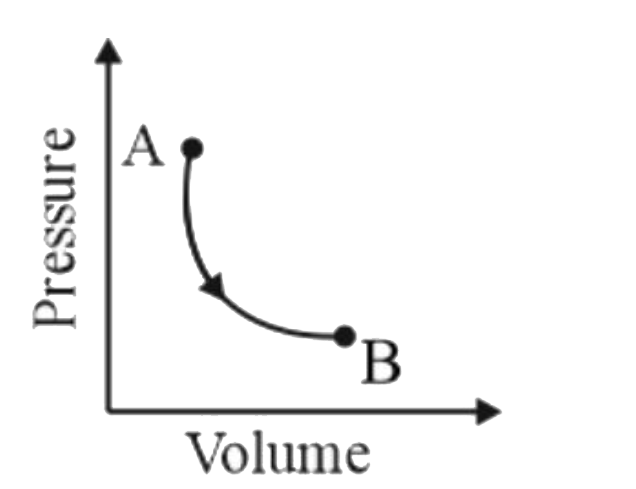The pressure of an ideal gas is written as p=2E3V.Here E refers to
(a)translational kinetic energy
(b)rotational kinetic energy
(c)vibrational kinetic energy
(d)total kinetic energy.
The correct Answer is:A
To solve the question "The pressure of an ideal gas is written as p=2E3V. Here, E refers to what?" we will follow these steps:
Step 1: Understand the given equation
We are given the equation for pressure p in terms of energy E and volume V:
p=2E3V
Step 2: Rearrange the equation
We can rearrange this equation to express energy E in terms of pressure p and volume V:
pV=2E3
Multiplying both sides by 32 gives:
E=32pV
Step 3: Relate pressure to the ideal gas law
From the ideal gas law, we know that:
pV=nRT
where n is the number of moles, R is the gas constant, and T is the temperature in Kelvin.
Step 4: Substitute the ideal gas law into the energy equation
Substituting pV from the ideal gas law into our expression for E:
E=32(nRT)
Step 5: Relate energy to degrees of freedom
According to the equipartition theorem, the total energy E of an ideal gas can also be expressed as:
E=F2kBT
where F is the number of degrees of freedom, and kB is the Boltzmann constant.
Step 6: Identify the degrees of freedom for an ideal gas
For a monatomic ideal gas, the number of degrees of freedom F is 3 (corresponding to motion in the x, y, and z directions). Thus, we can express the energy as:
E=32kBT
Step 7: Conclusion
From our calculations, we see that the energy E refers to the translational kinetic energy of the gas particles. Therefore, the correct answer is that E refers to the translational kinetic energy.
Final Answer
E refers to the translational kinetic energy.
---
We are given the equation for pressure p in terms of energy E and volume V:
p=2E3V
We can rearrange this equation to express energy E in terms of pressure p and volume V:
pV=2E3
Multiplying both sides by 32 gives:
E=32pV
From the ideal gas law, we know that:
pV=nRT
where n is the number of moles, R is the gas constant, and T is the temperature in Kelvin.
Substituting pV from the ideal gas law into our expression for E:
E=32(nRT)
According to the equipartition theorem, the total energy E of an ideal gas can also be expressed as:
E=F2kBT
where F is the number of degrees of freedom, and kB is the Boltzmann constant.
For a monatomic ideal gas, the number of degrees of freedom F is 3 (corresponding to motion in the x, y, and z directions). Thus, we can express the energy as:
E=32kBT
From our calculations, we see that the energy E refers to the translational kinetic energy of the gas particles. Therefore, the correct answer is that E refers to the translational kinetic energy.
E refers to the translational kinetic energy.
Topper's Solved these Questions
Similar Questions
The energy density uV of an ideal gas is related to its pressure P as
View Solutionvan der Waal's equation for calculating the pressure of a non ideal gas is
(P+an2V2)(V−nb)=nRT
van der Waal's suggested that the pressure exerted by an ideal gas , Pideal, is related to the experiventally measured pressure, Pideal by the equation
Pideal=Preal↑observed pressure+an2V2↑currection term
Constant 'a' is measure of intermolecular interaction between gaseous molecules that gives rise to nonideal behavior. It depends upon how frequently any two molecules approach each other closely. Another correction concerns the volume occupied by the gas molecules. In the ideal gas equation, V represents the volume of the container. However, each molecule does occupy a finite, although small, intrinsic volume, so the effective volume of the gas vecomes (V-nb), where n is the number of moles of the gas and b is a constant. The term nb represents the volume occupied by gas particles present in n moles of the gas .
Having taken into account the corrections for pressure and volume, we can rewrite the ideal gas equation as follows :
(P+an2V2)corrected pressure(V−nb)corrected volume=nRT
AT relatively high pressures, the van der Waals' equation of state reduces to
View SolutionThe pressure p and volume V of an ideal gas both increase in a process.
View SolutionThe pressure and volume of an ideal gas are related as pα1v2 for process A→B as shown in figure . The pressure and volume at A are 3p0andv0 respectively and pressure B is p0 the work done in the process A→B is found to be [x−√3]p0v0 find

View SolutionAssertion Pressure of a gas id given as p=23E.
Reason In the above expession, E represnts kinetic energy of the gas per unit volume.
View SolutionAt low pressures, the van der Waals equation is written as [P+aV2]V=RT
The compressibility factor is then equal to
View SolutionThe pressure P and volume V of an ideal gas both decreases in a process.
View SolutionTemperature of an ideal gas is 300 K . The final temperature of the gas when its volume changes from V to 2V in the process p=αV (here α is a positive constant) is
View SolutionTemperature of an ideal gas is 300 K. The change in temperature of the gas when its volume changes from V to 2V in the process p = aV (Here, a is a positive constant) is
View SolutionThe average kinetic energy of the molecules of an ideal gas at 10∘C has the value (E). The temperature at which the kinetic energy of the same gas becomes (2 E) is.
View Solution